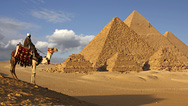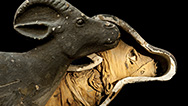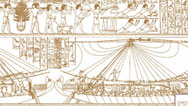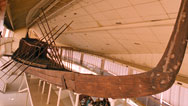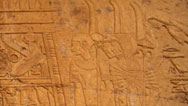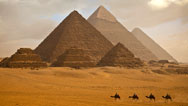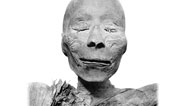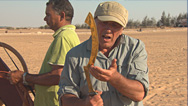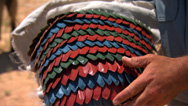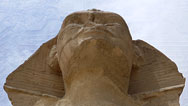
Building Pharaoh's Ship
Can the legendary trading vessel of an Egyptian queen sail again? Airing December 19, 2012 at 9 pm on PBS Aired December 19, 2012 on PBS
- Originally aired 01.12.10
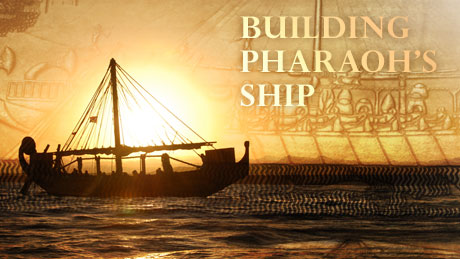
Program Description
Transcript
Building Pharaoh's Ship
PBS Airdate: January 12, 2010
NARRATOR: The ancient Egyptians created some of the greatest wonders on Earth—pyramids, temples, statues—but they are far less known for their mastery of the sea.
CHERYL WARD (Coastal Carolina University): People never think about the Egyptians as seafaring people, but they should.
NARRATOR: Thirty-five-hundred years ago, one of Egypt's most controversial pharaohs claimed to launch an epic journey on the open sea.
TOM VOSMER (Maritime Archaeologist): This is absolutely amazing.
NARRATOR: Now, for the first time ever, a team of archaeologists and builders will try to reconstruct that pharaoh's ship. Following a trail of ancient evidence, from temple wall reliefs, to coils of ancient rope, to remarkably intact boats, they will use traditional tools to try to build a vessel strong enough to endure the rough waters of the Red Sea.
By modern standards, the design is unusual and maybe even dangerous.
DAVID VANN (Author, A Mile Down): I've never sailed anything like this. The technical term would be a "pig," you know, a short, fat boat that's going to move terribly through the water.
NARRATOR: Can they make a ship worthy of a pharaoh?
TOM VOSMER: I am a little bit afraid, yes. I think it's silly not to be afraid.
NARRATOR: Can they prove that the Egyptians were among the greatest shipbuilders and traders of the ancient world or will the experiment end in disaster?
DAVID VANN: As a captain, I'm doing something different than I would normally do, and I'm really worried about that.
NARRATOR: Building Pharaoh's Ship,...
CHERYL WARD: Sails picking up water!
NARRATOR: ...right now, on NOVA.
Arriving today, at the port city of Alexandria, in Egypt, is some precious cargo: 60 tons of timber to be used in a highly unusual experiment. A team of archaeologists and builders is attempting to recreate one of the great wonders of ancient Egypt.
Egypt is filled with spectacular wonders—temples, pyramids, tombs—all built on an enormous scale, thousands of years ago. But the ancient pharaohs' engineers may have mastered another kind of wonder, one they don't usually get credit for: fantastic seagoing ships.
CHERYL WARD: When people think about Egypt, they think about pyramids, they think about King Tut, they think about tombs. They might think about the Nile, but they never think about the Egyptians as seafaring people. And they should.
NARRATOR: But how, exactly, did the Egyptians become master shipbuilders 3,500 years ago?
Pulling together all the ancient evidence, archaeologist Cheryl Ward and her team will try to design, build and sail a seagoing ship just like the pharaoh's.
CHERYL WARD: I wanted to show that by using the archaeological evidence, we could build a ship in Egyptian style, with Egyptian construction, and succeed.
NARRATOR: Direct evidence of Egypt's seafaring exploits is hard to come by, but some pharaohs left intriguing clues.
One of the most spectacular journeys was described here, at the sprawling funerary temple of the pharaoh Hatshepsut, who ruled around 1500 B.C. Carved onto the temple walls are five massive seagoing ships, setting out on the Red Sea and returning loaded with luxury items. The epic journey was proclaimed a triumph, one that could solidify the power of the pharaoh behind it—especially if that pharaoh were a woman.
Hatshepsut started out as a queen, married to a pharaoh. When he died, his son, from another wife, was just a young child.
CHERYL WARD: Hatshepsut became the regent, or guardian, acting head of state, for this four-year-old child. But she stepped into the role as a full king.
NARRATOR: If Hatshepsut wanted to retain full power as pharaoh, she would have to win the support of the temple priests. One way to do that was to deliver one of the most prized commodities of ancient Egypt: incense.
It was used constantly in temple ceremonies, a gift to the gods.
CHERYL WARD: The Egyptians used a lot of incense. It was scarce. It didn't come from Egypt. They had to get it from their faraway contacts. If Hatshepsut could get the priests the incense they craved and needed, she would establish herself as a strong, effective and powerful leader.
NARRATOR: Back then, the best source for incense like frankincense and myrrh was a land called Punt.
No one knows exactly where Punt was.
KATHRYN BARD (Boston University): What we know about Punt is the materials that came back from Punt.
NARRATOR: Things like ivory, ostrich eggs, giraffe and panther skins could all come from an area hundreds of miles south of Egypt in what is today Sudan or Eritrea.
To get there on the turbulent Red Sea, Hatshepsut would need tough, seagoing ships. But how could the Egyptians manage to build such vessels?
That's what Cheryl wants to find out.
She's organized a team of experts: an Egyptian archaeologist, Mohamed Abd-el-Maguid, and Tom Vosmer, an American who specializes in reconstructing ancient ships.
TOM VOSMER: I'd like to talk to Mohamed about how much this has changed since it got here.
NARRATOR: The building itself will mostly be done by the Lahma family, several brothers who run a shipyard about 50 miles from Alexandria and have a lot of experience with modern wooden boats.
They're led by Mahrous and Reda. Their oldest worker, Mosaad, is the most familiar with traditional building techniques and tools, like the adze, achieving amazing precision with the simple, sharp tool. And they seem fearless about their toes.
The team's first task is shaping and assembling the ship's keel, the central, bottom line of the ship's hull. The keel acts as a spine that everything else will be built around.
CHERYL WARD: Every boat that's ever been built begins with laying the keel and the precision with which these shipwrights work, with these very simple tools: levers, wedges, strings with the plumb bob.
NARRATOR: The shipwrights are using the plumb bob to make sure the enormous pieces of wood are in precisely the right place.
The laying of the keel is a ritual this ship shares with most others, even modern ones. But once that's done, these shipwrights will be heading into unfamiliar waters, because ancient Egyptian vessels were structurally nothing like today's boats.
Very few ancient boats have survived the millennia since pharaonic times, but one that has is absolutely spectacular. It was found at the most famous site in Egypt, the Giza Plateau, where three pharaohs built some of the biggest tombs in the world, along with the Great Sphinx.
The pharaoh Khufu started the project about 4,500 years ago, with the Great Pyramid. At its foot, archaeologists uncovered a boat-shaped pit. Inside was a pile of wood. When the scraps were assembled, this elegant boat, which may have been used in Khufu's funeral, took shape.
The fantastically preserved Khufu boat shows the incredible precision of the ancient shipwrights and reveals an unusual construction technique, vastly different from how ships are made today.
CHERYL WARD: Modern ships are built very differently from ancient ships. Modern ships get their strength from the frames. The frames are set up on a keel, they act like a skeleton for a thin skin of planking that is nailed on the outside.
NARRATOR: But none of the old Egyptian boats were built this way.
CHERYL WARD: Look at these timbers. Aren't they amazing?
NARRATOR: On Khufu's boat, there's no obvious skeleton. Instead, it's all skin.
The thick, irregularly shaped planks fit together like a jigsaw puzzle, held, not with nails, but with mortise-and-tenon joints. And, as this model shows, to add more support, rope was threaded through the planks and tightened to keep them from sliding apart.
Building these kinds of boats required massive pieces of wood.
TOM VOSMER: I'm quite overwhelmed by the size of the timbers. I think it's an incredible amount of wood.
NARRATOR: Egypt has never been a great place to find giant trees.
The pharaohs built their boats with enormous cedar trunks, imported from Lebanon. But today, the cedars of Lebanon are rare, so all this wood came from Europe.
CHERYL WARD: These trees, which were cut in France, they are about 120 years old. We chose to use Douglas fir, because its physical properties are most like ancient cedar.
NARRATOR: But even if we have the right kind of wood, how can we know what this ship looked like?
Khufu's boat is a masterpiece of nautical engineering and contains lots of clues, but this slender, graceful boat was never meant for sea travel. It's a ceremonial rowboat that floated only on the Nile River.
We want to build something much more substantial: a sturdy, seagoing sailing ship.
But evidence of these boats is much more elusive.
To find some clues, Cheryl Ward and ancient-boat expert Tom Vosmer head south from Cairo, boarding a train to Luxor. Their destination? The grand funerary temple of the pharaoh Hatshepsut, built about 1,000 years after the Great Pyramids.
Here, the ancient wall reliefs show up best at night.
A series of carvings shows several large sailing ships at different stages of a journey, their crew, rigging and cargo shown in amazing detail, even after 3,500 years.
TOM VOSMER: This is absolutely amazing, isn't it?
CHERYL WARD: It's stunning. It's just stunning. The detail is so precise. These are seagoing ships, they're great seagoing ships. They're huge. They are work ships; they're not covered with fancy paintings, they don't have elaborate pavilions on them, they do not have ribbons and flags. They have people who are rowing, people who are sailing. They have the cargoes piled up. They are a veritable treasure house of information about the seafaring of ancient Egypt.
NARRATOR: According to the inscriptions here, the ships were sent by the pharaoh Hatshepsut to journey to a faraway land, called Punt, or "God's land," thought to be about 800 miles down the coast of the Red Sea.
But even with these elaborate pictures, some historians still find it hard to believe that the Egyptians could have pulled off such an ambitious journey.
CHERYL WARD: In spite of the details on the reliefs, modern scholars still argued constantly about where Punt was. They didn't understand how the Egyptian technology would have let them get there. And there were some people who said they were just ships on the Nile, that they never went to sea.
NARRATOR: Cheryl wants to prove, once and for all, that the doubters are wrong.
With the help of a naval architect, she turns one of Hatshepsut's two-dimensional ships into a 3-D model, and starts designing the 66-foot-long replica, plank by plank.
CHERYL WARD: There are a lot of difficulties right now, because there are literally thousands of decisions to be made: how long is this plank? How wide is this plank? What angle should this shape be? Every plank is unique. We have about 45 planks on each side, and they all fit together in an interlocking way.
NARRATOR: Back at his workshop, Tom Vosmer starts making a scale model, carving each tiny plank to fit with its neighbors.
TOM VOSMER: One of the amazing things, I think, in western minds anyway, is that there's no skeleton to build this boat around, we build the hull plank first and the planks—the shapes of these planks that I'm working on now—actually determines the shape of the hull. Not the shape of any frame or molds or anything like that.
CHERYL WARD: It's like a puzzle. We have to put it together, and each piece must fit exactly to the other, to keep the water out and the ship floating.
TOM VOSMER: It's very complex. It's confusing me now. Basically what I'm doing right now is just experimenting with how these pieces go together and how we need to cut them. You can see, for example, this piece is cut two angles here; it's curved here; it's cut here; it's got a little hook here and another little angle there. It's a really very, very complex three-dimensional puzzle.
NARRATOR: Working out a three-dimensional puzzle with tiny scraps of wood is one thing, but how will the plan work with full-scale timbers?
When Tom presents his model to the Lahma brothers, things become a bit more clear.
TOM VOSMER: That's the initial few strakes of planking.
CHERYL WARD: Very nice, Tom.
TOM VOSMER: ...trying to understand how these all fit together. These two were very easy, this one is easy, these two: very difficult.
I think, with this model, they have been able to see in the three dimensions what is perhaps a little bit confusing in two dimensions. But now they can translate it completely from the drawing to this and go "Ah ha, this is how it works."
They understand the complexity of it; they understand the joinery. Nobody's built a ship like this for thousands of years.
NARRATOR: The shipwrights are used to working in wood, but they've never built a boat of this design, where each giant plank will have a unique shape.
CHERYL WARD: Each plank is sculpted to fit exactly in place. That means that you take your piece of wood, you don't bend it, because they didn't bend wood, they carved it, just like you would carve a statue.
NARRATOR: And it's not just the jigsaw-puzzle structure of the ship that's new to the builders. They've got to attach the pieces together in a completely different way from modern boats. And it's still got to be secure enough so that, even on rough seas, the boat won't fall apart.
So how did the ancients do it?
On the Khufu boat, the planks were held together by a combination of mortise-and-tenon joints and rope lashing. But how were Hatshepsut's ship-planks held together?
There's no way to tell from the reliefs. What's needed are remains from actual seagoing vessels.
For years, Cheryl and other marine archaeologists have been diving along Egypt's coastlines, in both the Mediterranean and the Red Sea, searching for ancient Egyptian shipwrecks.
They all came up empty-handed.
CHERYL WARD: I looked underwater for the remains of Egyptian seagoing ships, and we found nothing but sand.
NARRATOR: But now, some striking new discoveries could finally provide the answer.
The location is the desert site of Mersa Gawasis, about 100 miles northeast of the temples of Luxor, and right on the shores of the Red Sea. Just recently, archaeologists started uncovering amazing artifacts here, all related to ancient Egyptian seafaring.
More than a dozen stone anchors are found at the site.
When Cheryl is invited to visit, more surprises await inside a series of manmade caves.
CHERYL WARD: As you walk around some of the rock fall, suddenly you realize that on the floor of that are coils of rope that have not a grain of sand on them, laying there just like the Egyptians left them about 3,800 years ago. They're perfectly preserved.
KATHRYN BARD: It's absolutely the most rope that anyone's ever seen from ancient Egypt. It looks as if it was made yesterday. It looks exactly like modern rope.
NARRATOR: Kathryn Bard, one of the lead archaeologists here, finds more clues in the sand nearby: a pile of wooden crates, 3,800 years old.
KATHRYN BARD: We found an inscription on one of the boxes that in translation said: "The wonderful things of Punt." So, that could not be a better answer to what they were used for.
So there's no question, in my mind, that this was a harbor from where the Punt expeditions were sent and that they arrived back successfully with the "wonderful things of Punt."
NARRATOR: Punt was the place Hatshepsut claimed to have sent several ships to gather luxury goods.
The boxes and rope are fantastic discoveries for lead archaeologists Kathryn Bard and Rodolfo Fattovich. But, for Cheryl, the most intriguing finds are several large planks of wood, found scattered around the camp, buried in the sand.
They might not look like much, but, to Cheryl's expert eye, their peculiar shapes fit right into the ancient drawings of Egyptian ships.
RODOLFO FATTOVICH (Archeologist): Which part of the boat is this one?
CHERYL WARD: This is from the Punt relief, of course, and what we see is...this is a plank that can fit exactly here, and it touches here, on the center strake.
NARRATOR: Plank after plank is uncovered, riddled with holes—holes drilled, not by tools, but by shipworms. Shipworms are actually saltwater mollusks that burrow into submerged wood.
CHERYL WARD: They're riddled with shipworm. Shipworms are only found in the sea. When I look at these planks, I know they're from seagoing ships.
NARRATOR: This is what Cheryl has been looking for for years, physical evidence of a pharaoh's seagoing vessel.
CHERYL WARD: Every piece of wood that we find here tells us so much more than we ever knew. Even if we had only one piece, it would tell a new story.
NARRATOR: One of the amazing stories these planks tell is how the Egyptian shipwrights joined their planks together. The thick planks have mortise holes for double rows of mortise-and-tenon joints.
But unlike the Khufu river boat, there are no holes for lashing the planks together with rope.
Cheryl is intent on following the ancient evidence, so this is the method the Lahma family will use on our replica ship: giant, thick pieces of timber, carefully carved and held together with lots and lots of mortise-and-tenon joints.
TOM VOSMER: Now they're marking it. They'll plane a little more, make it a tighter fit, a closer fit.
NARRATOR: With nothing tying the planks together, no one really knows if this boat will hold up once it hits the high seas.And the builders and Tom are wondering: with this strange, ancient ship design, how will they keep the water out?
CHERYL WARD: Trying to understand how to keep the inside of a ship dry preoccupies everybody who has any kind of boat at any time.
NARRATOR: Today's wooden ships are made watertight with caulking. Natural materials like cotton, or synthetics like silicone, are hammered and squeezed into the joints between the planks.
But the ancient planks Cheryl has seen seem clean.
CHERYL WARD: I have never seen any evidence of caulking, no material, no tool marks, nothing that would show that the Egyptians would have pounded material in between their plank seams, like you do on a modern boat.
NARRATOR: The lack of caulking troubles Tom. Without it, he fears, the joints won't be tight enough to hold out the water, especially if the ship is being jostled by rough sea waves.
But Cheryl has her own plan.
CHERYL WARD: Our plan is to sink the ship after it's built. To let it sit, submerged in water, for two weeks, allowing the planks to swell around their joints, and seal the joints more tightly together to keep the water out.
NARRATOR: For this method to have any chance of making the ship watertight, the joints, before swelling, need to be nearly perfect.
At the shipyard, seeing water poured onto the joints, Tom is feeling less confident in the plan.
TOM VOSMER: I just can't believe that there's no caulking whatsoever, there must have been something. It's almost inevitable, I think. I don't see how you can get a perfect fit over these oddly shaped planks, with the thickness they are, without something in there. And the archaeological evidence is thousands of years old; something could have disappeared.
NARRATOR: Tom is painfully aware of the importance of a watertight ship. The last boat he built sank on its maiden voyage.
TOM VOSMER: It's a very strange feeling, as your feet sort of leave the deck and you get lighter and lighter, and suddenly the boat's not there supporting you anymore. It's a very strange feeling, rather frightening, as well.
NARRATOR: Despite Tom's fears, the shipwrights forge ahead.
Over several months, the extended Lahma family works away at the boat's hull.
Shipbuilding skills are passed on from parent to child, just as they were in ancient times. The Lahmas are carrying on a tradition that stretches back thousands of years, in Egypt. Since the very beginning, so much of Egyptian life revolved around the water.
CHERYL WARD: The Egyptian civilization grew up along the Nile. For thousands of years, people lived on its bank, and they crossed its waters. They used the water as a highway. The Egyptians weren't isolated, though. They didn't only focus on the Nile. They were part of a globalized system.
NARRATOR: According to ancient inscriptions, even during the Old Kingdom, 4,500 years ago, in the age of the pyramids, Egypt was already actively trading with other cultures: wood from Lebanon, wine and olive oil, also, from the eastern Mediterranean. But experts have debated whether the Egyptians used their own boats or relied on foreign shipbuilders.
Some believed that the Egyptian approach to boat-building wouldn't be good enough for sea travel. Now, we have a chance to find out if a ship held together almost exclusively with mortise-and-tenon joints will be sturdy enough for the Red Sea.
As the hull nears completion, the team gets an important new member. Long-distance sailor David Vann will serve as the ship's captain, if it ever makes it into the water.
David is immediately struck by the shape of the hull.
DAVID VANN: My first impression was that it looked like a giant wooden salad bowl and a really beautiful one. I've never sailed anything like this. This is the kind of boat they were sailing, up to 4,000 years ago. But compared to a boat now, of course, it will...the technical term would be a "pig." We would call it a pig now, you know, it 's a beamy, heavy, you know, short, fat boat that's going to move terribly through the water.
NARRATOR: Modern sailboats are narrower, with pointy keels that help grip the water and keep them from capsizing. This rounded hull looks like it could roll right over.
But the round, tubby shape isn't David's only concern.
DAVID VANN: I'm a little worried about this. I, I had a crack once in a boat, just a little hairline crack, and the title of my book about it is A Mile Down, because that boat sank in 5,000 feet of water—a big 90 foot, very strong steel boat—because of a little crack, and these are really big cracks.
As a captain, you're really not ever supposed to go sea in something that you think could possibly break, and so, you know, for the sake of the project, I'm doing something different than I would normally do, and I'm really worried about that. If we could just dip the whole thing in epoxy, that would be great, but I'm not sure they were using epoxy systems 4,000 years ago. So we'll see.
NARRATOR: The team is still determined to make the ship sound without any epoxy.
Following the ancient ship evidence, the shipwrights add a series of horizontal beams. They'll support the deck, but, more importantly, they'll help lock together the jigsaw puzzle pieces of the hull.
It's just about time to find out if this ship can be made watertight.
CHERYL WARD: The first thing we want to do is sink the boat, let it fill with water, let everything swell. And then we'll pump the water out of the inside and see if it's watertight. Maybe we need to do something else, and at that point we decide what to do.
NARRATOR: For the shipwrights, getting the boat to this moment, when it is moved into the Nile for the first time, is a huge accomplishment.
MOSAAD EL-HEDEK (Shipwright/In Arabic): Launching this boat is a truly wonderful thing for us, and, God willing, if we can do this, then we can meet any difficult challenge.
NARRATOR: But it's hard to maintain a celebratory mood when your ship quickly fills with water and sinks into the river.
Of course, according to Cheryl, this is all part of the plan. Still, to some crew members, it comes as a surprise.
SHIPWRIGHT(In Arabic): Why is the boat filled with water?
YOSRY LAHMA (Shipwright/In Arabic): Who said it wouldn't fill with water? It has to fill with water.
NARRATOR: Cheryl thinks the sinking of new ships was the norm for the Egyptians, but launching into the Red Sea was even more complicated, because the ships weren't built anywhere near the coast.
According to ancient inscriptions, seafaring ships were built on the Nile River, 90 miles from the sea.
CHERYL WARD: This was just incredible. What the Egyptians did was to completely build a ship on the Nile, then take it apart. Every single piece was disassembled. They loaded those disassembled pieces on donkeys and, with a train of men and donkeys in the thousands, walked across 90 miles of desert, to reach the shores of the Red Sea.
KATHRYN BARD: It wasn't easy at all. One inscription describes an expedition to Mersa Gawasis of 3,756 men.
CHERYL WARD: It's no wonder Hatshepsut bragged about this. It's a huge, huge undertaking.
NARRATOR: At the boatyard, the crew is dealing with their own huge undertaking. For weeks, the ship sits in the Nile River, filled with water.
Today, the crew starts to pump the water out.
By the end of the day, the boat is high and dry. The question is, will it stay that way?
Unfortunately, it doesn't. The ship is still riddled with leaks.
MOHAMED ABD-EL-MAGUID (Underwater Archaeologist/In French): We have a problem. At first, everything was going really well, but now...
(In Arabic) Do you think the archaeologists were crazy not to have reacted earlier, even though they were aware of the problem and did nothing to fix it?
REDA LAHMA (Shipwright/In Arabic): Go ahead. Go ahead, Mahrous, you answer that one.
MAHROUS LAHMA (Shipwright/In Arabic): The thing is, it's not a question of them being ignorant or anything. We expected the wood to swell more than it did, so it's because of the wood.
NARRATOR: The plan has not worked, and there's not much agreement about why. Some crew members blame the condition of the wood. Others say the joints weren't tight enough or it was crazy to build the boat without caulking in the first place.
Whatever the reason, if they want the ship to float, they've got to get it out of the water and find a way to plug the holes.
Tom immediately pushes to caulk the seams.
TOM VOSMER: So this is linen fiber? I wonder what would happen if we put this between our planks?
NARRATOR: The Egyptians definitely had linen and at the Red Sea camp at Mersa Gawasis archaeologist Kathryn Bard even found scraps of it buried in the sand.
KATHRYN BARD: We have excavated a lot of little tiny fragments of linen at the site. So possibly linen was used to stick into the cracks.
NARRATOR: The builders decide to use a combination of linen strips with soft beeswax. We don't know for sure if the Egyptians used this technique, but the materials were definitely available to them.
CHERYL WARD: Beeswax is a natural product. We know the Egyptians used it on their coffins, they used it on their furniture. We see it used as a fixative for their paints. So, I felt comfortable using natural fiber and beeswax just to fill the gaps. And it's working very well.
NARRATOR: This time, when the ship hits the water the seams hold.
The hull is finally finished and floating, but it's not about to go anywhere. For that, it will need some rigging.
Fortunately, Hatshepsut's reliefs show the ropes and sails in fantastic detail. And ancient ship models found in Egyptian tombs provide more clues.
The whole arrangement is known as a square rig, and it's very different from most of today's sailboats.
CHERYL WARD: The Egyptian rig is really simple. There's a central mast, there are two long pieces of wood we call "yards," that spread the sail, and lots and lots and lots of rope.
NARRATOR: Today, rope is still made by traditional methods in the streets near the shipyard, by twisting together plant fibers.
SHIPWRIGHT (In Arabic): You say they've done this for hundreds of years?
HAMDY LAHMA (Shipwright/In Arabic): Yes, the same, the exact same way.
NARRATOR: And of course, they'll need a sail.
To hold all this in place, the ship requires a sturdy mast. This massive tree trunk weighs just about a ton. The shipwrights get it aboard with just a ramp and a couple of ropes.
Next, comes the rigging. The mast has to hold and organize the web of ropes that will support the yardarms and sail.
According to Hatshepsut's reliefs, the top of the mast was rigged with a masthead, outfitted with metal loops that held more than a dozen ropes.
The team has replicated the design on our full-size mast, and now it's time to thread the loops.
DAVID VANN: It's such strange rigging. It's nothing like I've ever seen before. This is based on the relief. It's just a brand-new experience. I've never seen anything like it.
NARRATOR: With all the ropes finally looped through the masthead, now they have a much tougher task: getting the mast upright.
CHERYL WARD: What we're doing is getting ready to put the heel of the mast in this very small hole.
NARRATOR: For a modern ship, this would be done easily with a crane, but we're just using ropes, and as many guys as we can find at the shipyard.
The boat is built, and David Vann is eager to find out if it is truly seaworthy. Though the ancient Egyptians took their ships apart and loaded the pieces on donkeys for the journey to the Red Sea, our boat will stay in one piece and get a ride on an eighteen-wheeler.
As it's transported from the Nile shipyard to a Red Sea port near Mersa Gawasis, reality starts to set in.
Tom Vosmer has no idea how the boat will perform.
TOM VOSMER: I am a little bit afraid, yes. We don't know the boat; we don't know the conditions; we've never sailed this kind of boat before. It's silly not to be afraid.
NARRATOR: One of the big fears is that the boat, with a high center of gravity and a round hull, might easily tip over. To make the ship more stable, the crew stows about nine tons of sand to act as ballast.
DAVID VANN: This boat requires a huge amount of ballast. It's very important, because it gives us stability when we are sailing, so we don't tip over too much and dip a rail and turtle and sink—slightly important!
CHERYL WARD: I'm most concerned about stability. I have no idea what's going to happen when we get on the ship. In some ways, I'm terrified.
NARRATOR: Finally, the moment has arrived to take the ship out into open water on the Red Sea and find out if it can hold up.
Soon after the boat is towed from the dock, the stability fears seem justified.
CHERYL WARD: Oh, I don't like the way this feels.
NARRATOR: Things don't feel much better when the crew tries out the oars.
DAVID VANN: Okay, so let's row now. This thing rocks a lot.
NARRATOR: No one wants the ship to capsize and sink, but just in case disaster strikes, a support boat is always nearby.
DAVID VANN: So now we're going to try to sail, raise the sail, and just have three rowers on each side.
NARRATOR: Everyone is anxious to get the sail up; maybe the forward momentum will reduce the rocking.
CHERYL WARD: Just learning how to raise the sail was a challenge, because this very, very heavy sail and yard had to be hauled up without the help of pulleys.
Sails picking up water!
NARRATOR: Then, suddenly, as the sail fills with wind, everything changes.
CHERYL WARD: I just feel stunned as the sail goes up and the wind catches it. I just can't believe it's actually sailing.
DAVID VANN: I want to just go straight downwind first, see how it is, what the speed is, and then we can change a little, see how the speed is.
NARRATOR: Captain David Vann points our ship southward.
DAVID VANN: Let's turn to port a little bit.
NARRATOR: Most scholars agree this is the direction Hatshepsut's ships would have sailed. Though the exact location of ancient Punt is still a mystery, it was most likely hundreds of miles down the African coast. For most of the year, the wind blows from the north.
CHERYL WARD: To sail south along the African coast of the Red Sea is easy. The prevailing wind is at your back. It pushes you along in a nice simple path, and you end up at Punt.
NARRATOR: Our crew won't be sailing that far, but they'll sail as far as they can in the right direction. And up to now, the ship is performing well.
CHERYL WARD: I am thrilled. I had no idea how smooth, how easy it would feel to be on this ship, with this glorious, ancient sail.
TOM VOSMER: I'm really impressed. The thing is tracking well. I mean we got the wind coming from just aft of the beam. We're making good speed, can't complain about that.
NARRATOR: To everyone's surprise, even with a rounded hull, the boat manages to stay on course.
The credit probably goes to a pair of giant steering oars lashed to the stern of the ship.
TOM VOSMER: This is really impressive.
DAVID VANN: I've never sailed anything like this at all, but what I'm amazed at is it feels like a modern boat. It's very solid, very stable, moves well. It amazes me that they had this 4,000 years ago, because it's not a bad sailboat, even today.
NARRATOR: The trip is beginning to seem easy, maybe too easy.
Then one night, the weather turns and the wind comes up. It's clear that the Red Sea has a bigger test in store for the ship and its crew.
DAVID VANN: Most of us didn't sleep last night with how much it was rocking—really wildly—and there was a lot of wind. And today, there's too much wind to do the full sail. There's about 20 knots of wind, and that's too much for our main sail.
NARRATOR: With much stronger winds putting too much force on the large sail, the cotton cloth could rip, so the crew will try out a smaller sail they brought along.
DAVID VANN: Not, not a lucky turn of events for us, because we've only had a couple days on this boat, and it would be nice if the conditions could remain a little lighter. So we'll see.
CHERYL WARD: I was really apprehensive. The waves were 10 feet high in some cases, and we had no idea how the ship would respond. It was scary.
Where is your lifejacket? Lifejacket!!
DAVID VANN: We don't really have solid information on how far over this boat has to go to turtle and really go over, but we took some water over the port rail, so that was certainly exciting.
CHERYL WARD: Okay, we need to do something pretty quickly here.
NARRATOR: Even though the ship, held together with just wood and rope, creaks and groans, it manages to weather the storm. And despite the rocking, it surfs gracefully over the crests of the waves.
The ship is sailing faster than anyone expected, so Cheryl thinks the trip to Punt might have taken just a month. Getting back would have taken longer. With the winds from the north, the Egyptians may have had to row back, or they might have sailed in a circle around the opposite coast of the Red Sea.
Either way, the crew is convinced this ship could handle the journey.
TOM VOSMER: Probably the thing that will stick with me the most is just the thrill of surfing down those waves and just feeling the whole boat move and the power it had and the incredible power that that sail has. I mean, we were doing seven knots sometimes, and it was really good fun.
NARRATOR: And though he called it a pig, Captain David Vann is amazed at how safe and effective the ship feels.
DAVID VANN: What I love about this rig is it's incredibly easy to sail downwind. It's my favorite boat I've ever sailed on—and that includes many modern boats—for sailing downwind. I think it's wonderful. I think it's fun to sail. I would sail across an ocean with this. I think it's fun.
CHERYL WARD: I'm ecstatic. We showed that a ship built with ancient technology, based, as much as possible, on duplicating archaeological evidence, can easily sail the Red Sea. No one can argue that Egyptian technology wasn't sufficient for that. In fact they've got to rethink their whole approach to understanding seafaring in the ancient world.
NARRATOR: The ancient Egyptians have always been honored as kings of the Nile, but now finally, they can be celebrated as masters of the sea.
Broadcast Credits
Building Pharaoh's Ship
- Produced by
- Valérie Abita
Patrick Villeneuve - Directed by
- Stéphane Bégoin
- Edited by
- Steve Audette
Scott Stevenson - Narration Written by
- Julia Cort
- For Sombrero & Co
- Line Producer
- élisabeth Perez
- Production Accountant
- Béatrice Barbat
- Production Accountants
- Annouk Guerin
Eric Hallier - For NOVA
- Produced for NOVA by
- Julia Cort
- Associate Producer
- Cass Sapir
- Assistant Editor
- Mandy Minichiello
- Production Credits
- Narrated by
- Craig Sechler
- Additional Voice Over
- Ramsey Faragallah
Adam Alexi-Malle - Music
- Christopher Rife
Bernard Becker and Arnaud de Boisfleury
Ray Loring - Animation
-
Stephen Flynn
Sputnik Animation - Camera
- Madjid Chir
José Gerel
Stephen McCarthy
Raymond Collet
Bill Mills
Arnaud Lavaleix
Alexandre Abrard
Mike McCue
Karen Cox Dennis
Alexandre Besson
Georges Lafitte - Sound Recordists
- Denis Guilhem
Brooks Lester
George Shafnacker - Assistant Director
- Yannick Fauchier
- Location Managers
- Hakim Cherikh
Antonin Depardieu
Paul Geday
Hugues Peyret - Casting
- élisabeth Perez
Soria Moufakkir - Assistant Camera
- Olivier Rostan
Hugo Bachelet - Head Gaffer
- Guillaume Brunet
- Gaffers
- Julien Dyan
Julia Gueritault - Head Grips
- Tristan Morin
Jean-Luc Delarue - Grips
- Peter Rauber
Julien Saffroy
Alexis Oros - Art Directors
- Isabelle Huchet
Claire Belloc - Property Manager
- Martine Belloc
- Photographer
- Fanny Begoin
- Online Editors
- Elisée Fritz
Michael H. Amundson - Colorist
- Michael H. Amundson
- Audio Mix
- Mix One Studios
- Sound Editor
- Christopher Anderson
- Production Assistant
- Karinna Sjo-Gaber
- Research Intern
- Kate Sokol
- Archival Material
- DeA Picture Library / Art Resource, NY
Erich Lessing / Art Resource, NY
Francois Guenet / Art Resource, NY - Special Thanks
- The team of Ebad el-Rahman shipyard, Rashid, Egypt
The crew of "Min"
Mersa Gawasis excavation team
The citizens of the city of Rashid, Egypt
Mr Nasser Kamel, Egypt Ambassador in France
Ehab Badawy and Rania Wagdy
Egypt press and information office - Paris and Cairo
Guillaume Desgrées du Lou - French Embassy in Cairo
Dimitri Meeks
Luc Gabolde
Bill Greer
Bob Bischoff
Arnault Duhard
Joyce Tyldesley
Patrice Pommey
Emad Khalil
Patrick Louisy
Angélique Berkane
Christine Le Goff
Jean-Luc Verdier
Calypso Hotel, Safaga
Association Science & Télévision
Rosita Cannata
Formation Design Systems
Andrew Dempsey
Shelley Wachsmann - NOVA Series Graphics
- yU + co.
- NOVA Theme Music
-
Walter Werzowa
John Luker
Musikvergnuegen, Inc. - Additional NOVA Theme Music
- Ray Loring
Rob Morsberger - Post Production Online Editor
- Jim Ferguson
- Closed Captioning
- The Caption Center
- NOVA Administrator
- Mykim Dang
- Publicity
-
Carole McFall
Eileen Campion
Victoria Louie
Karinna Sjo-Gaber
Karen Laverty - Marketing
- Steve Sears
- Researcher
- Kate Becker
- Senior Researcher
- Gaia Remerowski
- Production Coordinator
- Linda Callahan
- Paralegal
- Sarah Erlandson
- Talent Relations
- Scott Kardel, Esq.
Janice Flood - Legal Counsel
- Susan Rosen
- Production Assistant
- Ryan Murdock
- Post Production Assistant
- Darcy Forlenza
- Associate Producer, Post Production
- Patrick Carey
- Post Production Supervisor
- Regina O'Toole
- Post Production Editors
- Rebecca Nieto
Jason York - Post Production Manager
- Nathan Gunner
- Compliance Manager
- Linzy Emery
- Development Producer
- Pamela Rosenstein
- Supervising Producer
- Stephen Sweigart
- Business Manager
- Joseph P. Tracy
- Senior Producer and Project Director
- Lisa Mirowitz
- Coordinating Producer
- Laurie Cahalane
- Senior Science Editor
- Evan Hadingham
- Senior Series Producer
- Melanie Wallace
- Managing Director
- Alan Ritsko
- Senior Executive Producer
- Paula S. Apsell
A NOVA production by Sombrero & Co for WGBH Boston in association with
ARTE France, Unité de Programme Découverte et Connaissance Hélène Coldefy; NHK - Japan, Osato Tomoyuki, Sayumi Horie; Le Musée du Louvre, Production audiovisuelle Catherine Derosier-Pouchous; Essential Media for BBC, Executive Producer Chris Hilton; GA & A Productions - Italy; SBS - TV Australia; With the participation of Discovery Canada, Planète, Planète Thalassa, La R.T.B.F - Télévision Belge - Claire Colart, La Télévision Suisse Romande (TSR); With the support of MEDIA program of the European Union, Centre National de la Cinématographie, Région Ile-de-France, PROCIREP and l'ANGOA - Société des producteurs, International Sales, Arte France Distribution
© 2009 WGBH Educational Foundation
All Rights Reserved
- Image credit: (image composite) © WGBH Educational Foundation
Participants
- Mohamed Abd-el-Maguid
- Underwater Archeologist www.underwaterdiscovery.org/Sitemap/Homepage/AboutUs/CommonShowTeamMember.aspx?&XmlDocument=0118.xml
- Kathryn Bard
- Boston University web.bu.edu/phpbin/africa/profiles/app/details.php?id=40
- Mosaad el-Hedek
- Shipwright
- Hamdy Lahma
- Shipwright
- Mahrous Lahma
- Shipwright
- Reda Lahma
- Shipwright
- Yosry Lahma
- Shipwright
- David Vann
- Author, A Mile Down www.davidvann.com/
- Tom Vosmer
- Maritime Archeologist
- Cheryl Ward
- Coastal Carolina University ww2.coastal.edu/cward/drward.php
Preview
Full Program
Full program available for streaming through
Watch Online
Full program available
Soon


